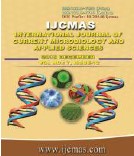


 National Academy of Agricultural Sciences (NAAS)
National Academy of Agricultural Sciences (NAAS)

|
PRINT ISSN : 2319-7692
Online ISSN : 2319-7706 Issues : 12 per year Publisher : Excellent Publishers Email : editorijcmas@gmail.com / submit@ijcmas.com Editor-in-chief: Dr.M.Prakash Index Copernicus ICV 2018: 95.39 NAAS RATING 2020: 5.38 |
Termite mound is a rich source of nutrients and applied as a fertilizer, thus improving the productivity of soil. The role of termites in increasing the productivity of forest soils depends mainly on the micro flora presents in the gut of termites. The result of the present study revealed that the bacterial population in termite soil ranged from 68.4 – 138.2 X 106 cfu/g sample dry weight. While the fungi and actinomycetes populations ranged from 32.0 – 88.5 X 103 cfu/g and 12.8 – 28.2 X 103 cfu/g sample dry weight respectively. Among the bacterial population, Azotobacter and Beijerinckia were found predominant bacteria and both are produced higher levels of exopolysaccharide. The bacterial population of the fungus combs ranged from 25.6-36.2 x 106cfu/g sample dry weight. The fungi and actinomycetes populations ranged from 92.8 – 112.8 x 104 and 8.4 – 13.1 x 103cfu/g sample dry weight respectively. The results indicated that the fungal population was higher in fungal comb when compared to bacteria present in termite soil. The predominant fungus present in fungal comb was identified as Termitomyces. Further the Termitomyces growth condition was optimized and the study revealed that cellulose is a preferred carbon for the growth of Termitomyces compared with other tested sugars and pH ranged between 4.5 – 5.0 and temperature between 37-400C were identified as suitable pH and temperature for their effective growth of Termitomyces isolates.
 |
 |
 |
 |
 |